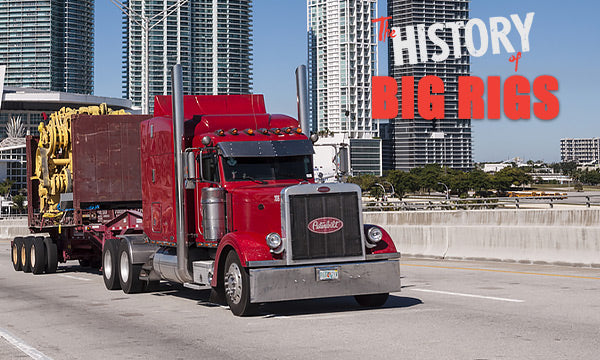When it comes to heavy-duty vehicles and power, few can compare with the massive engines and incredible hauling power of commercial transport trucks. Big rigs, semi-trucks, 18-wheelers – no matter what you call them, we see these powerful vehicles every day and, whether we think of it or not, these big rigs and their drivers are essential to our way of life.
At the beginning of the 20th century, the railroad was the king of the industry - if anyone needed large or heavy goods transported, they used the rails. Even then, the very beginning of a revolution had begun, when a small company named Mack began production of tough, reliable, and heavy-duty trucks.

From Rails to Roads
During World War I, trucking companies rapidly grew to fill war-time shipping needs that were greater than the railroad's ability to service. By the end of the war, the value and potential of commercial trucking was clear. The changing industrial landscape of the US in the 1920s opened the door, and industry eyes, to the potential of commercial transport trucks. The railroads were about to be challenged.
Emerging trucking companies filled gaps that the rails simply couldn't - offering more flexibility and service to rural areas that were too sparsely populated to make laying rail financially viable.
The continual improvement of US roads hastened the growth of the trucking industry. Federal programs to fund the building of roads began in the early 1920s and built thousands of miles of roads. In 1922 alone, federal grants for the improvement of highways resulted in the construction of over 10,000 miles of roads.
As roads across the US continued to improve, commercial trucking found a foothold in more industries across the country. In the late 1930s, the lumber industry in the Pacific Northwest faced increasingly expensive transport of timber from the forests to mills. A company by the name of Peterbilt soon met this demand.

Trucking in World War II
With the entry of the US into World War II, the trucking industry changed immensely as companies like GMC and Mack produced heavy-duty trucks for use by the military. The most important of these trucks was the GMC CCKW. Known as the "Jimmy", over half a million of these trucks were used by the US military. They were vital for providing supplies to the US troops.
Following D-Day, the US military faced a difficult situation. The bridges and railways in France were destroyed, and the US military was advancing farther into France and running short on supplies. The US army called into service these 2 ½ ton 6 x 6 trucks to meet the vital supply needs of the troops. Called the Red Ball Express, a fleet of these trucks, emblazoned with a red ball, traveled through France in all weather and all conditions to bring ammunition, medical supplies, and reinforcements to the front line. Knowing that lives were on the line, the drivers would often disable the engine governors so that they could travel faster than 56 miles per hour. The Red Ball Express consisted of nearly 6,000 trucks at its peak, delivering over 12,000 tons of supplies a day. General Eisenhower wrote that senior officers considered it one of the six most vital US vehicles in winning the war.

Big Rigs After the War
Following the war, trucks that supplied the US, and the companies who made them, found even greater importance in the booming post-war economy. It was a time of growth, and the surging economy meant more US demand for goods. With the advent of the interstate system in the 1950s, trucking had truly come of age. Long haul drivers carried more and more materials and goods from one end of the country to the other on new, open roads - better than the country had ever seen before.
Once a limiter on the trucking industry's capacity, the Motor Carrier Act was amended as part of deregulating the trucking industry that was becoming more important than ever to the country's economy. As trucking eclipsed the declining railroad, truck drivers became a vital part of US infrastructure, and trucking companies saw an opportunity to capture a more significant portion of the ballooning market by innovating in what comforts they were able to provide drivers working long hours in all conditions. Truck manufacturers began improving suspension and cab design - including sleepers that were accessible without exiting the truck.

Modern Trucking in the US
The phrase "If you bought it, a truck brought it" is truer every day in the USA. In 2012, big rigs moved 10 trillion dollars of freight in the US - a considerable portion of the $13 trillion in total. Today, over 3.7 million trucks and their drivers transport over 700,000 tons of goods and products each year in the US alone.
As the dominant transporter of goods in the US, over 80% of communities rely on truckers to bring them everything from medical supplies to groceries to electronics. Semi-truck manufacturers are still striving to build efficiency and advancements in the industry, finding ways to make rigs more fuel-efficient or more powerful. But many of their innovations aim to increase comfort for truckers - supporting those men and women who are essential to maintaining our way of life.
From their humble beginnings, big rigs have grown from a small segment of our country's transportation sector to one we truly couldn't do without.

